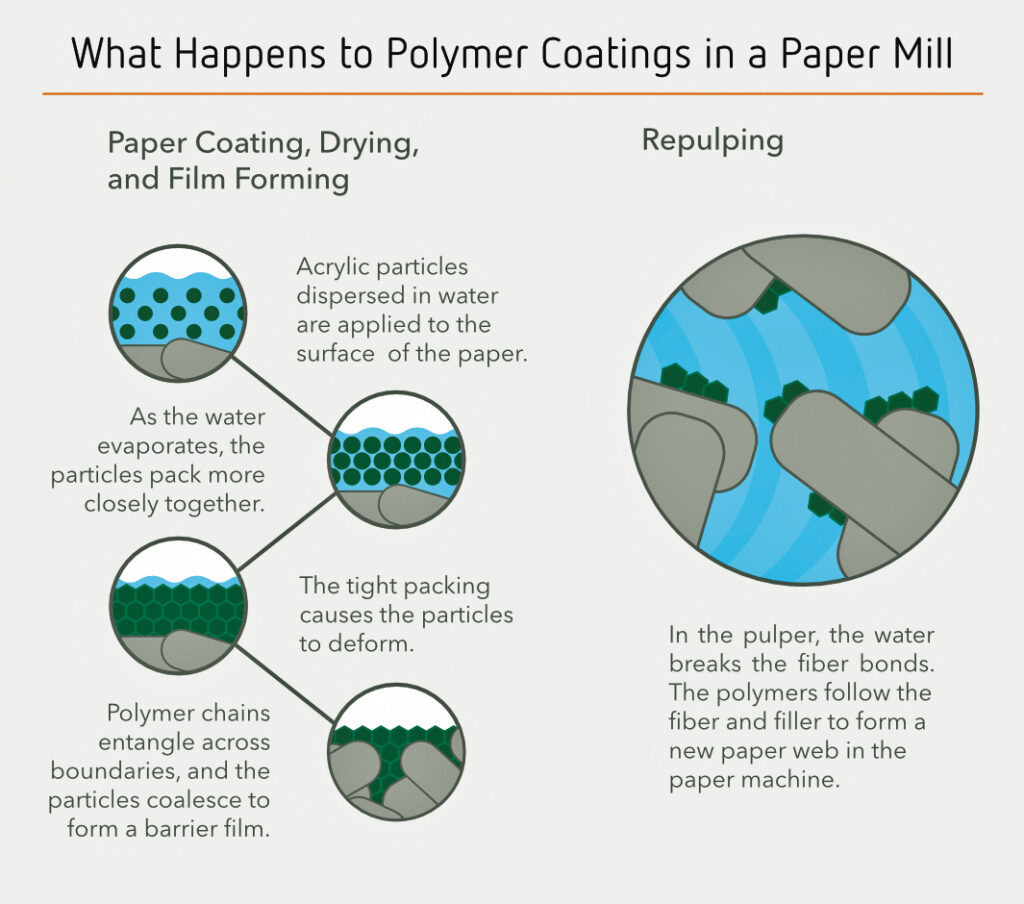OLIVER KALMES
For paper, recycling has higher priority over composting in the Sustainability Pyramid and the Circular Economy. This is because it guarantees that paper’s valuable fibers will be reclaimed for reuse. However, even though paper fibers can be recycled many times (up to 25 times, depending on the type of fiber and end-use), fiber degradation is a concern, as fibers tend to become shorter and weaker after multiple rounds of recycling. Because of this, fibers are sorted before processing. Screened-out fiber or waste can be incinerated at end of life for energy recovery, e.g., combustion for steam and electrical energy production, with carbon neutral emissions.

Composting offers no reuse of valuable fibers and no recovery of energy. It is “cold incineration” without utilizing or recovering the entrapped energy; it can also lead to the production of methane. Furthermore, there is no way for foreign substances to be screened out efficiently. Thus, materials such as metal, plastic, process chemicals, functional chemicals, and microplastics can be released into the environment if the compost is used as fertilizer or soil improver. Composting is only a viable alternative to recycling in cases when it is difficult to recycle, such as an item heavily contaminated with food. Composting should be viewed as an opportunity to divert food waste from landfills.
EFFECTS OF POLYOLEFIN FILMS ON RECYCLING PROCESS
Plastic film—like polyester, polypropylene, polyethylene, or others—when laminated to paper, creates many recycling issues for paper mills. The use of laminates is increasing, and mills are having a hard time processing the increased amount of film. Film decreases the capacity of a paper mill’s pulper because it takes more time for the paper to repulp due to the plastic film protecting the fibers from water. The strong plastic film will either be sorted out using a specific drum-shaped pulper and bypass systems, or beaten down into smaller flakes, which increases the energy needed to separate the fibers from the filmic flakes.
In any case, the higher the amount of plastic films in the recycling mix, the higher the amount of waste, the higher the cost for separation, and the higher the cost for disposal. A laminated paper-plastic film is also difficult to recycle as a plastic, as the paper fibers cause contamination and are difficult to extract from the film.
REPLACING PLASTIC FILM WITH WATER-BASED BARRIER COATINGS
Water-dispersed emulsion polymer coatings—sometimes referred to as polymeric coatings—are often used as barrier/functional coatings on paper to replace plastic film and give paper specific functionality, such as grease resistance, water repellency, moisture vapor, aroma or oxygen barrier, and heat sealing. The polymer material forms a continuous thin film that can not function as a main structural component of the final article, as it does not have structural integrity on its own; nor does it add to the structural integrity of the final product.
These water-based barrier coatings behave similarly to traditional binders used in pigment-coated papers for decades. In repulping, the water-based barrier coating particles will either stick to the fibers or fillers, or follow these appropriate fiber/filler recycle streams:
• Form new paper sheets (80-99 percent of the mass);
• Separate during stock preparation (via screens, washers, cleaners, flotation, deinking) for incineration or material supply for cement factories, street works, etc. (1-20 percent of the mass);
• Separate at the wet end of a paper machine, de-watered (via final cleaning stages), and sorted for incineration or material supply for cement factories, street works, etc. (1-20 percent of the mass);
• Be washed with water, fiber-broke, fillers, etc. and sent to a wastewater treatment plant for separation (flotation or sedimentation) (1-2 percent of the mass).
The biological (aerobic or anaerobic) and/or physiochemical treatment transforms these particles into sludge. The sludge is either incinerated or sent to a landfill. Some mills pump the sludge back into the middle layers of their board.
Barrier coatings for heat seal at very low temperatures can be tacky and create agglomerates of tacky substances known as “stickies” in the web forming and drying stages when recycled. Controlling the formation of stickies can be managed by choosing the right barrier, using sticky control measures such as masking additives, and limiting the amount of barrier coated papers added to the recycled paper mix (or by separating it with deinking cells).
Many polymer barriers are hydrophobic and attract inks in the recycling process, resulting in dirt spots. Therefore, if deinking is not part of the recycling process, it is preferable to reuse barrier-coated papers for the production of grades where color consistency is not important.
CONCLUSION
When using the standard paper waste stream, functional water-based barrier coatings have the following advantages over paper-plastic film structures like PE, PP, and PET:
• Improved recyclability with easier processing, less plastic waste, and less contamination;
• Minimal release of microplastic particles into the environment;
• More efficient use of resources, as only relatively small amounts of water-based barrier coatings are necessary to reach specific and sufficient functionality.
Oliver Kalmes is territory sales manager, printing and packaging (Europe, Middle East, and Africa) for Michelman. Michelman is a member of CEPI’s 4evergreen group, which is a cross-industry alliance to boost the contribution of fiber-based packaging for a circular and sustainable society and economy to minimize climate and environmental impact. Visit michelman.com.
 Paper 360
Paper 360

